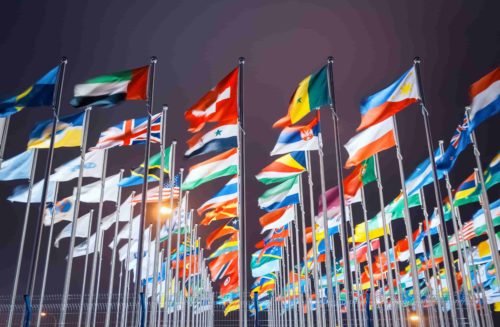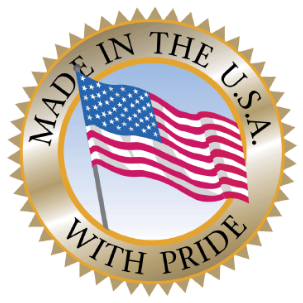Flag Color Meanings

Steve Doorlag
Every country in the world has a flag, and flags embody more than only countries. They can represent an organization, a church, a charity, and more.
The very first flags came about for two reasons. They were used in battle to represent an army or a nation, and they were used by people to connect to a higher power (such as a God).
Flags were then used on boats (to identify which were friendly and which were not) and in ports (so you would know which port you were docking in). From there, flags have come to represent all the countries around the world.
They contain symbols, shapes, patterns, and colors.
But what are the flag color meanings?
Colors
There are many colors used in flags, here are some of the most common.
Red
Red is a symbol of love and life. It can represent passion and emotion, and it can also signify blood. As we know from everything around us, red can be a sign of danger, anger, and power, and the same is true for flags. Red is a strong color in Islam and is a lucky color in China.
China is one of the most famous red flags, and you will also find red in Scandinavian flags like Norway’s and Denmark’s, among others around the world.
Blue
Blue is the color of tranquility and calmness. If you think about it, you can come to the conclusion that blue represents vast swathes of water or sky, and many early cultures used blue to signify that. The color can also be used to signify loyalty, trust, wisdom, and harmony.
Many South American countries use blue in their flags, with Guatemala and Argentina being two of the most prominent.
Yellow
Yellow is an energizing color and can stand for happiness. It is the color of the sun, so that energy can be used to mean the internal energy of a group of people or the energy that the sun bestows upon the crops and land. Buddhists see yellow as the color of humility, while, to China, yellow is the imperial color. Yellow can also be a warning color.
You will find lots of yellow in the Lithuanian, Ghanain, and Colombian flags.
Green
Green is all about fertility and growth. Green is the color of the grass, the new leaves, the plants, and more. It is a stable and safe color, that can also show peace, harmony, and freshness, especially the deeper shades of green.
Green is the most prominent color in the Nigerian and Saudi Arabian flags.
Orange
When you combine red and yellow, you get orange. And, if you combine the attributes associated with those colors, you end up with strength, passion, and activity. It is also the color of joy, positivity, creativity, enthusiasm, and revolutionary ideas.
Orange is a common color in Buddhism and Hinduism. You will find it on the flags of India, Ivory Coast, and the Republic of Ireland.
Purple
Purple, a combination of red and blue, can mean passion and wealth. It is a flag color that is associated with luxury, elegance, and independence. Of all the colors on our list, purple is the one that is used in flags the least. This is mainly because purple was traditionally a more expensive color of dye, so many flags had already been designed before it became a cheaper substance.
We could only find two flags with purple in them: Dominica and Nicaragua.
White
White can signify peace and innocence. While many flags have white in them, it is often not the focal color. It is the color of purity and can show perfection, while also symbolizing the color of light. Traditionally, white flags in wars were a sign of surrender, though this is not the meaning in national flags, and it can also represent death.
England, Cyprus, and Japan all showcase white as the main color of their flag.
Black
Black can signify the absence of light, or complete darkness and the mystery that comes with it. It can also be a sign of power and strength. Many countries relate black to both life and death.
There are not really any national flags that have black as the main color, but Yemen does have a flag that is one-third black.
Color Combinations
It is unusual for a flag to only showcase one color, though there are some. So, what are some of the most regularly used color combinations?
Red, White, & Blue
As you may be able to guess, especially when you consider that these colors make up the American flag, these three colors together signify revolution and freedom. The French tricolor serves as an inspiration.
Along with America and France, you will also find these three colors on the Cuban, Liberian, and Paraguayan flags, among others.
Red, White, & Blue (Take 2)
While these colors signify freedom and revolution, they also belong to a specific group of countries. These are the colors of the Pan-Slavic nations, each of them sharing the same three colors.
The Pan-Slavic nations include Russia, Croatia, Czech Republic, Serbia, Slovakia, Slovenia, and Yugoslavia.
Red, Yellow (Gold), & Green
Just as red, white, and blue belong to the Pan-Slavic countries, red, yellow, and green belong to Pan-African countries. You will find many African flags with these three colors, including Cameroon, Ethiopia, Ghana, Zambia, and many more.
Red, White, Black, & Green
These four colors are the main color base for the Pan-Arab countries. You will find these four colors on Iraq, Jordan, Kuwait, Sudan, Syria flags, among others.
Flag Facts
There are so many flags out there, but here are some of our favorite facts about common flags.
A Flag Of A Different Color
While the flag of Nepal does contain regular flag colors (red, white, and blue), it is the only flag in the world that does not have four sides. It looks more like two triangles, with one on top of the other and both points pointing to the right.
The Exact Same Colors
Monaco and Indonesia both have the same colors and shape. The top half of the flag is red and the bottom half is white. The only difference is the size. The Indonesian flag is a little wider.
Only One Color
There is no flag with only one color, but there used to be. Up until 2011, the Libyan flag was solid green.
Combining Other Flags
The flag of the United Kingdom combines the colors and shapes of three of the four flags that are a part of the UK: Scotland, Ireland, and England. Sorry, Wales.
Wrapping Up
Many countries have had flags for hundreds of years, and many have only formed recently, but they all have one thing in common: colors. Each flag has at least one color on it, and those colors are used to represent the characteristics of that country.



